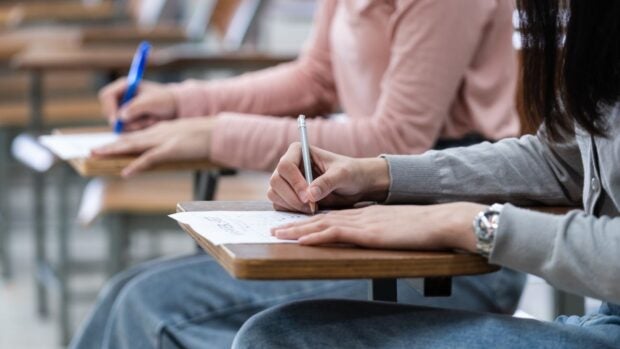MANILA, Philippines — According to the latest Programme for International Student Assessment (Pisa), the average scores of Filipino students in reading, mathematics, and science have not improved significantly, as anticipated by the Department of Education (DepEd). The scores remain low compared to students from other countries.
The 2022 Pisa study, which covered 690,000 students from 81 countries, revealed that the Philippines’ performance in the three subjects was similar to that of 2018 when it first participated in the assessment.
In the 2018 Pisa, the country scored the lowest in reading and second lowest in math and science among 79 participating nations.
For the 2022 assessment, the Philippines ranked sixth to the last in reading and mathematics, while science ranked third to the last among 81 countries.
The 7,193 Filipino students from 188 schools averaged 355 points in mathematics, still way below the OECD average of 472. Their average scores of 347 in reading and 356 in science were also lower than the global averages of 476 and 485, respectively.
Compared to the country’s 2018 average scores in mathematics (353), reading (340), and science (357), the latest results did not show any significant improvement, the report noted.
‘Minimum level’
Pisa is a global study conducted by the Organization for Economic Cooperation and Development (OECD) that assesses the academic performance of 15-year-old students in three subjects every three years.
It is also the first study to provide insights into the impact of the pandemic and school closures on education systems worldwide.
According to the study conducted from 2018 to 2022, the gap between the highest-scoring Filipino students and the weakest or lowest-scoring learners narrowed in mathematics, although it did not significantly change in reading and science.
“In mathematics, low achievers became stronger, while performance did not change significantly amongst high achievers,” it said.
Compared to the average across OECD countries, only a small proportion of Filipino students were recognized as top performers in at least one subject.
READ: House panel OKs substitute bill to expand aid to teachers, students in private schools
“At the same time, a smaller proportion of students than on average across OECD countries achieved a minimum level of proficiency (Level 2 or higher) in all three subjects,” the report added.
In mathematics, the Philippines ranked sixth to last and only fared better than Guatemala, El Salvador, Dominican Republic, Paraguay and Cambodia.
According to the report, 16 percent of Filipino students reached at least Level 2 proficiency in the subject, significantly less than the average across OECD countries.
According to a report, over 85% of students in Singapore, Macao (China), Japan, Hong Kong, Chinese Taipei, and Estonia have achieved Level 2 proficiency or above.
This means that these students are capable of interpreting and recognizing how to mathematically represent a situation without direct instructions. For instance, they can compare the total distance across two alternative routes or convert prices into a different currency.
Ranking from bottom
“Almost no students in the Philippines were top performers in mathematics, meaning that they attained Level 5 or 6 in the Pisa mathematics test (OECD average: 9 percent),” the report said.
On the other hand, six Asian countries and economies had the largest shares of top math performers: Singapore, 41 percent; Chinese Taipei, 32 percent; Macao (China), 29 percent; Hong Kong (China), 27 percent; Japan, 23 percent; and Korea, 23 percent.
READ: DepEd Mandaue chief to students: Avoid fights, don’t let anger get the best of you
According to the report, students who achieve this level of proficiency can use mathematical modeling to solve complex problems and can evaluate and select appropriate problem-solving strategies.
In reading, the Philippines also ranked sixth to last with an average score of 347, followed by Kosovo (342), Jordan (342), Morocco (339), Uzbekistan (336) and Cambodia (329).
Only 24 percent of Filipino students attained Level 2 or higher in reading, just a third of the OECD average of 74 percent.
“At a minimum, these students can identify the main idea in a text of moderate length, find information based on explicit, though sometimes complex criteria, and can reflect on the purpose and form of texts when explicitly directed to do so,” the report said.
According to a report, the percentage of 15-year-old students who achieved the minimum level of reading proficiency varied globally from 89 percent in Singapore to 8 percent in Cambodia.
In science, the Philippines ranked third to last with an average score of 356 points, followed by Uzbekistan with 355 and Cambodia with 347.
Only 23 percent of Filipino students who took the test attained Level 2 or higher in science, which is significantly lower than the OECD average of 76 percent.
“At a minimum, these students can recognize the correct explanation for familiar scientific phenomena and can use such knowledge to identify, in simple cases, whether a conclusion is valid based on the data provided,” the report said.
The dismal performance of the Philippines in the 2018 Pisa prompted DepEd to address issues and challenges in attaining quality basic education in the country.
Under then Education Secretary Leonor Briones, the agency decided to lead “aggressive reforms” such as reviewing and updating the K-12 curriculum, improving learning facilities, and upskilling and reskilling teachers and school heads through professional development programs.


